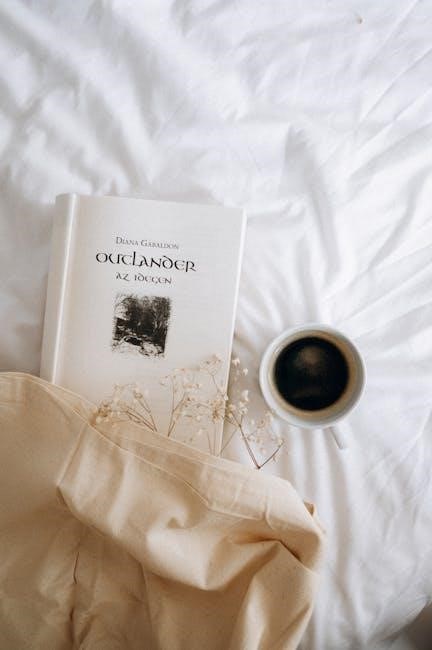One Flew Over the Cuckoo’s Nest, written by Ken Kesey, is a timeless novel exploring themes of freedom, individualism, and societal control. Published in 1962, it tells the story of Randle McMurphy, a rebellious patient in a psychiatric hospital, and his clash with the oppressive Nurse Ratched. The book is a powerful critique of authoritarian systems and has become a classic in American literature.
The novel’s Gothic undertones and vivid characters, such as the silent but observant Chief Bromden, add depth to its exploration of human resilience and conformity. Its enduring impact on literature and film, including the iconic 1975 movie adaptation, solidifies its place as a cultural landmark.
1.1 Overview of the Novel
One Flew Over the Cuckoo’s Nest, authored by Ken Kesey, is a gripping narrative set in a psychiatric hospital during the 1960s. The story revolves around Randle McMurphy, a rebellious patient who challenges the rigid authority of Nurse Ratched, and the mute yet perceptive narrator, Chief Bromden. Exploring themes of freedom, control, and individualism, the novel critiques oppressive systems and societal norms. Its vivid characters and haunting setting make it a profound commentary on human resilience and conformity, solidifying its status as a literary classic.
1.2 Historical Context and Background
One Flew Over the Cuckoo’s Nest, published in 1962, reflects the societal tensions of its time. Set in an Oregon psychiatric hospital, the novel critiques the rigid medical practices and authoritarian structures prevalent in the era. Ken Kesey’s firsthand experience with mental institutions and his involvement in countercultural movements deeply influenced the story. The book’s exploration of freedom, control, and individuality resonated with the 1960s’ growing questioning of societal norms, making it a powerful commentary on its historical context.
Author Ken Kesey
Ken Kesey was an American novelist, best known for One Flew Over the Cuckoo’s Nest (1962). His work often explored themes of freedom and societal control, leaving a lasting mark on American literature as a countercultural icon.
2.1 Biography and Literary Career
Ken Kesey was born on September 17, 1935, in La Junta, Colorado, and grew up in Oregon. He studied at the University of Oregon and later became a prominent figure in the counterculture movement. Kesey’s experiences as a nurse and his experimentation with psychedelics deeply influenced his writing. His debut novel, One Flew Over the Cuckoo’s Nest (1962), became a literary phenomenon, exploring themes of freedom and societal control. He also wrote Sometimes a Great Notion (1964), solidifying his legacy as a bold and innovative writer.
2.2 Inspiration Behind the Novel
Ken Kesey drew inspiration for One Flew Over the Cuckoo’s Nest from his work as a nurse at a psychiatric hospital and his experiences with LSD. Observing the rigid hierarchy and oppressive routines, he crafted a narrative that critiques institutional control. The character of Randle McMurphy was inspired by Kesey’s own rebellious spirit and his fascination with individual freedom. The novel reflects his interest in the counterculture movement and the tension between conformity and personal autonomy, shaping its enduring themes.

Plot Summary
Randle McMurphy enters a psychiatric hospital, disrupting the rigid control of Nurse Ratched. His defiance inspires fellow patients, leading to a clash of wills and a quest for freedom.
3.1 Setting and Main Characters
The story unfolds in an Oregon psychiatric hospital during the 1960s, where the oppressive atmosphere is dominated by Nurse Ratched. The main characters include Randle McMurphy, a boisterous convict feigning insanity, and Chief Bromden, a silent, towering patient believed to be deaf and mute. These characters, along with others like Dale Harding and Billy Bibbit, form a diverse group navigating the hospital’s strict regime and societal pressures.
3.2 Key Events and Conflict
Randle McMurphy’s arrival at the hospital sparks immediate conflict with Nurse Ratched. His defiance challenges her authority, leading to power struggles and tension among patients. A violent clash between McMurphy and Nurse Ratched marks a turning point, resulting in his lobotomy. Meanwhile, Chief Bromden’s silent strength evolves, culminating in his liberation, symbolizing resistance against oppressive control. These events highlight the struggle for individual freedom versus institutional dominance.
Major Themes
Freedom vs. Control and Individualism vs. Conformity are central themes, exploring societal oppression and personal rebellion. The novel critiques institutional authority, highlighting the struggle for autonomy and self-expression.
4.1 Freedom vs. Control
Freedom vs. Control is a central theme in One Flew Over the Cuckoo’s Nest. Randle McMurphy’s rebellion against Nurse Ratched’s oppressive regime symbolizes the struggle for individual autonomy. The novel portrays a psychiatric hospital as a microcosm of societal control, where conformity is enforced through fear and manipulation. McMurphy’s defiance challenges this system, advocating for personal freedom and questioning authority. Kesey critiques oppressive structures, highlighting the tension between liberation and institutional dominance, resonating with broader societal themes of the 1960s.
4.2 Individualism vs. Conformity
Individualism vs. Conformity is a pivotal theme in One Flew Over the Cuckoo’s Nest. Randle McMurphy embodies individualism, challenging the strict conformity enforced by Nurse Ratched. His defiance inspires others to express their true selves, while the hospital’s oppressive environment demands submission. The novel explores the tension between personal identity and societal expectations, highlighting the consequences of resisting or embracing conformity. Kesey critiques the suppression of individuality, advocating for self-expression and autonomy in a rigidly controlled world.

Character Analysis
Randle McMurphy challenges authority, embodying rebellion, while Nurse Ratched enforces oppressive control. Chief Bromden, the silent narrator, observes the chaos, symbolizing hidden strength and societal oppression’s impact on individuals.
5.1 Randle McMurphy
Randle McMurphy is the protagonist, a free-spirited convict who feigns insanity to escape prison labor. His arrival disrupts the hospital’s rigid order, challenging Nurse Ratched’s authority. Charismatic and rebellious, McMurphy embodies freedom and defiance, inspiring fellow patients to resist oppression. His bold actions and refusal to conform highlight the tension between individuality and control, making him a symbol of resistance against oppressive systems. His journey explores the cost of rebellion and the power of the human spirit.
5.2 Nurse Ratched
Nurse Ratched is the tyrannical head nurse who rules the psychiatric ward with an iron fist. Her strict control and manipulative tactics maintain order through fear and humiliation. Patients live in dread of her punishments, which include public shaming and harsh treatments. Ratched’s calm demeanor belies her cruelty, as she crushes any dissent, embodying the oppressive systems that stifle individuality. Her clash with McMurphy highlights her determination to maintain power, making her a symbol of authoritarian control and societal oppression.
5.3 Chief Bromden
Chief Bromden, a towering half-American Indian patient, feigns deafness and muteness to avoid attention in the psychiatric hospital. His silent observation of the ward’s dynamics, particularly the clash between McMurphy and Nurse Ratched, provides unique insight. Bromden’s gradual transformation from a passive figure to a symbol of resistance underscores the novel’s themes of individuality and defiance against oppressive control, making him a pivotal character in the story’s exploration of freedom and societal constraints.
Writing Style and Structure
Ken Kesey employs a unique narrative voice through Chief Bromden, blending reality with delusional imagery. The novel’s structure explores institutional life, emphasizing themes of control and rebellion, while incorporating symbolic elements to deepen its psychological and societal commentary.
6.1 Narrative Voice and Perspective
The novel is narrated by Chief Bromden, a patient who feigns deafness and dumbness, offering a unique, intimate perspective on the ward’s dynamics. His narration blends delusions with reality, creating suspense and depth. Through Bromden’s eyes, readers experience the oppressive atmosphere and the patients’ struggles. Kesey’s choice of narrator adds layers of insight, allowing exploration of themes like control and rebellion. The PDF version preserves this narrative structure, maintaining Kesey’s intended emotional and psychological impact.
6.2 Use of Symbolism
One Flew Over the Cuckoo’s Nest is rich in symbolism, with Kesey using objects and events to convey deeper meanings. The glass door in the ward symbolizes the barrier between freedom and confinement. McMurphy’s fishing trip represents rebellion and liberation, while the Combine embodies oppressive societal forces. Bromden’s hallucinations of wires and machinery highlight his perception of the hospital as a controlling mechanism. These symbols reinforce the novel’s themes of freedom vs. control and individualism vs. conformity, adding layers of depth to the narrative.
6.3 Gothic Elements in the Novel
One Flew Over the Cuckoo’s Nest incorporates Gothic elements through its eerie setting and oppressive atmosphere. The psychiatric hospital, with its rigid routines and sterile environment, serves as a Gothic institution symbolizing confinement and dread. Kesey uses shadows, silence, and the towering figure of Nurse Ratched to create a sense of foreboding. Chief Bromden’s hallucinations of machinery and fog further enhance the Gothic tone, reflecting his fear of the hospital’s mechanical control. These elements amplify the novel’s critique of institutional power and its suffocating grip on individuality.
Critical Reception and Impact
One Flew Over the Cuckoo’s Nest received widespread critical acclaim for its bold exploration of freedom and control. It won the Pulitzer Prize and became a cultural phenomenon, inspiring the iconic 1975 film. The novel’s enduring relevance has solidified its place as a modern classic, influencing both literature and film while sparking debates on individuality and societal norms.
7.1 Reviews and Literary Criticism
One Flew Over the Cuckoo’s Nest received widespread critical acclaim for its bold exploration of freedom, control, and societal norms. Critics praised Ken Kesey’s vivid portrayal of life in a psychiatric hospital and the dynamic characters, particularly Randle McMurphy and Nurse Ratched. The novel’s themes resonated deeply, earning it a Pulitzer Prize and solidifying its status as a modern classic. However, some critics noted its controversial depiction of mental illness and the psychiatric system, sparking debates about its representation and message.
7.2 Cultural and Social Impact
One Flew Over the Cuckoo’s Nest had a profound cultural impact, challenging societal norms and sparking conversations about mental health and individual freedom. Its portrayal of institutional control resonated with the counterculture movement of the 1960s, making it a symbol of rebellion. The novel influenced both literature and film, with its 1975 adaptation winning multiple Oscars. It remains a significant work in American culture, continuing to inspire discussions on conformity and the human spirit’s struggle for autonomy.
Adaptations and Legacy
One Flew Over the Cuckoo’s Nest has been adapted into a successful film and stage play, cementing its cultural influence. The 1975 film, directed by Miloš Forman, won several Oscars, further popularizing the story and its themes. Stage adaptations have also brought the novel to life, ensuring its enduring legacy in both literature and performance art.
8.1 Film Adaptation (1975)
The 1975 film adaptation of One Flew Over the Cuckoo’s Nest, directed by Miloš Forman, is widely regarded as a cinematic masterpiece. Starring Jack Nicholson as Randle McMurphy and Louise Fletcher as Nurse Ratched, the film won five Academy Awards, including Best Picture, Best Director, Best Actor, Best Actress, and Best Adapted Screenplay. Faithful to Ken Kesey’s novel, the movie captures the struggle between individual freedom and oppressive authority, leaving a lasting impact on both film and literature. Its success solidified the story’s place in popular culture.
8.2 Stage Play Adaptations
One Flew Over the Cuckoo’s Nest has been adapted into several successful stage plays, with the first Broadway production debuting in 1963. These adaptations bring the novel’s themes of freedom and control to life through live performances, capturing the raw tension between McMurphy and Nurse Ratched. The plays have been praised for their ability to maintain the emotional depth and complexity of Kesey’s original work, offering audiences a unique perspective on the story’s timeless struggle between individuality and conformity.

Availability in PDF Format
One Flew Over the Cuckoo’s Nest is widely available in PDF format, offering readers a convenient way to access Ken Kesey’s 1962 novel. Published on February 1, 1962, it remains a popular psychological novel in English.
9.1 Benefits of the PDF Version
The PDF version of One Flew Over the Cuckoo’s Nest offers enhanced readability and portability. It retains the original formatting, ensuring a faithful representation of Ken Kesey’s work. With tools like Smallpdf or Adobe Acrobat, users can easily compress files for storage without losing quality. This format is ideal for academic research or personal reading, allowing annotations and highlights. The PDF also enables access on multiple devices, making it a versatile choice for modern readers.
9.2 Tools for Reading and Editing PDFs
Various tools are available for reading and editing PDFs of One Flew Over the Cuckoo’s Nest. Online platforms like Smallpdf and ILovePDF offer compression, conversion, and annotation features; Desktop software such as Adobe Acrobat provides advanced editing options. These tools enable users to customize their reading experience, highlight key passages, and securely share the document. Additionally, password protection and encryption ensure the file’s safety, making PDFs a versatile and reliable format for both academic and personal use.
One Flew Over the Cuckoo’s Nest remains a profound exploration of freedom, control, and individualism. Its lasting impact on literature and film ensures its relevance today, with the PDF version offering easy access to this timeless story.
10.1 Final Thoughts on the Novel
One Flew Over the Cuckoo’s Nest is a powerful exploration of freedom, control, and individualism, leaving readers with a lasting reflection on societal norms and personal autonomy. The novel’s vivid characters, particularly McMurphy and Nurse Ratched, symbolize the struggle between rebellion and oppression. Its timeless themes and emotional depth ensure its relevance across generations. The availability of the PDF version makes this classic accessible to modern readers, preserving Kesey’s poignant commentary on human resilience and conformity.
10.2 Recommended Reading
For deeper insights, readers can explore essays like Barry Ryan’s “The Third Space in Ken Kesey’s One Flew Over the Cuckoo’s Nest.” Additionally, works by authors like George Orwell and Aldous Huxley offer similar themes of societal control and individual freedom. The PDF version of Kesey’s novel is easily accessible via platforms like Smallpdf or Adobe Acrobat, ensuring timeless accessibility to this literary masterpiece.
